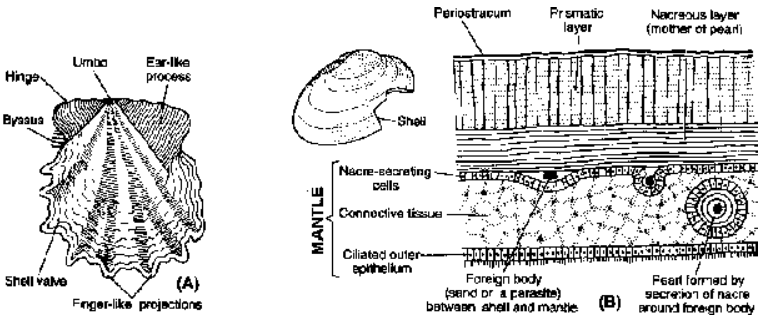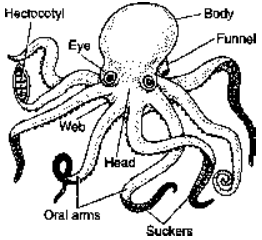Phylum Mollusca
Classification of Animals Non Chordates of Class 11
Study of mollusca constitutes a branch of zoology called malacology & that of their shells is called conchology.
General Characters
- Molluscs are essentially aquatic, mostly marine, few fresh-water & some terrestrial forms.
- The body is soft, unsegmented (except in monoplacophora), triploblastic & bilaterally symmetrical (In some molluscs like Pila, due to torsion during growth, the adults become asymmetrical).
- Body divisible into head, mantle, foot & visceral mass.
- Body is commonly protected by an exoskeletal calcareous shell of one or more pieces, secreted by mantle. Shell may be external (e.g., most of molluscs), internal (e.g., slug, cuttle fish, squid) or absent (e.g., Octopus).
- Head is distinct, bearing the mouth & provided with eyes, tentacles & other sense organs except the pelecypoda & scaphopoda.
- Mantle or Pallium is a thin, fleshy fold on the dorsal side. It is enclosed in a space, between itself & the body which is called mantle or pallial cavity.
- The body is lined with single-layered epidermis which is usually ciliated. Muscles are unstriped & occur in bundles.
- Ventral body wall is modified into a muscular, flat or plough-like surface, the foot which is variously modified for creeping, burrowing & swimming.
- Body cavity is haemocoel. The true coelom is generally limited to the pericardial cavity (space around the heart), and to small spaces within kidneys & gonads.
- Digestive tract is complete. Buccal cavity often contains a rasping organ, the radula, with transverse rows of teeth (except in Pelecypoda). In gastropods, scaphopods & cephalopods, the intestine becomes U-shaped bringing the anus to an anterior position.
- Respiration usually takes place by gills, called the ctenidia, located in the mantle cavity, but may occur by body surface, mantle or lung (pulmonary sac).
- The circulatory system is open. It includes dorsal pulsatile heart & a few arteries that open into sinuses. Blood consists of copper containing pigment known as haemocyanin.
- Excretion by paired metanephridia (kidneys). Gills are also excretory in function. The excretory matter is ammonia or uric acid.
- Nervous system consists of paired cerebral, pleural, pedal & visceral ganglia joined by longitudinal & transverse connectives.
- Sense organs include eyes (photoreceptors) and tentacles (tactoreceptors) on the head. Statocysts for equilibrium & osphradia for testing chemical & physical nature of water (chemoreceptor).
- Dioecious or monoecious; one or two gonads with gonoducts, opening into renal ducts or to exterior. Fertilization external or internal; development direct or indirect.
- There are three types of larva-trochophore, veliger (gastropoda) & glochidium (pelecypoda).

Fig. Representatives of six classes of Mollusca
Classification of Molluscs
Phylum Mollusca is divided into seven classes:
Class 1: Monoplacophora
The flattened, bilateral and oval body has some annelidian characters. For example, some internal organs exhibit metameric segmentation. There are also present nephridia. However, these animals are molluscs because they have characters of the phylum mollusca.
Body is enclosed in a mantle which secretes a dome-shaped outer shell. A broad and flat muscular foot is present for locomotion. Sexes are separate e.g., Neopilina.
Class 2: Polyplacophora
All marine.
Bilaterally symmetrical with elongated body having mouth and anus at opposite ends.
The head lacks eyes and tentacles. The ventral surface has a flat foot. The shell may consist of one to eight plates e.g., Chiton (coat of mail shells).
Class 3: Gastropoda
Terrestrial, fresh-water and marine forms.
The shell is made up of one piece enclosing the visceral mass. The head is distinct and has eyes and tentacles. The foot is flat and muscular.
The buccal cavity has an odontophore with a radula bearing chitinous teeth.
There is present a veliger larva during the development.
The early embryo is symmetrical with anterior mouth and posterior anus but during development the body twists bringing the anus near the mouth showing torsion so that the body becomes asymmetrical. Thus, in the adult forms, the mouth and the anus are anterior e.g., Pila, Limax.
Class 4: Scaphopoda
Marine and burrow in mud and sand.
Bilaterally symmetrical with tubular shell opening at both ends.
Head has many prehensile tentacles. The foot is conical and used for digging.
The sexes are separate. They are often called as tooth shells, e.g., Dentalium (Elephant tusk shell).
Class 5: Pelecypoda/Bivalvia
Fresh-water and marine forms.
Bilaterally symmetrical and body is enclosed by a bivalved shell. The two valves are joined dorsally.
Head is rudimentary which has no tentacles and eyes. The foot is wedge-shaped and used for digging.
The sexes are generally separate. During development, a trochophore larva is usually present e.g., Unio (Sea Mussel), Mytilus (Fresh water mussel).
Class 6: Cephalopoda/Scaphopoda
They are bilaterally symmetrical with well developed head and trunk. Head has mouth and eyes.
Some part of the foot is modified into prehensile tentacles of arms around the head. The remaining part of the foot forms a muscular funnel or siphon for expelling water from the body.
They may have external or internal shell. In some forms, the shell is also absent.
Sexes are separate. Development is direct e.g., Sepia (cuttle fish), Loligo (squid), Octopus (devil fish).
Class 7: Aplacophora
Body worm like with a mantle but no shell and foot.
Radula simple.
e.g., Neomenia, Chaetoderma.

Fig. A. Morphology of pearl oyster, B. Process of pearl secretion

Fig. Octopus
- Introduction
- Fundamentals of Animal Classification
- Body Plan and Symmetry
- Metamerism and Germ Layers
- Body Cavity or Coelom
- Protostomes And Deuterostomes
- Modern Classification of Animal World
- Five Kingdoms of Living World
- Kingdom Protista
- Protozoa
- Plasmodium
- Some Representatives of Phylum Protozoa
- Paramecium
- Phylum Porifera
- Canal System and Skeleton
- Some representatives of phylum - Porifera
- Cnidaria (Gr. Knide = nettle or stringing cell)
- Some representatives of phylum Coelentrata
- Phylum Platyhelminthes - The flat worms
- General Topics (Dugesia, Schistosoma, fasciola, Taneia solium)
- Important Points to Remember
- Phylum Aschelminthes
- Some representatives of Nematoda
- Phylum Annelida
- Polychaeta
- Oligochaeta
- Hirudinea
- Phylum Arthoropoda
- General Topics
- Important Points to Remember of Chelicerae
- Phylum Mollusca
- General Topics of Phylum Mollusca
- Important Points to Remember of Phylum Mollusca
- Phylum Echinodermata
- General Topics of Phylum Echinodermata
- Important Points to Remember of Phylum Echinodermata
- Exercise 1
- Exercise 2
- Exercise 3
- Exercise 4
- Exercise 5
- Exercise 6









